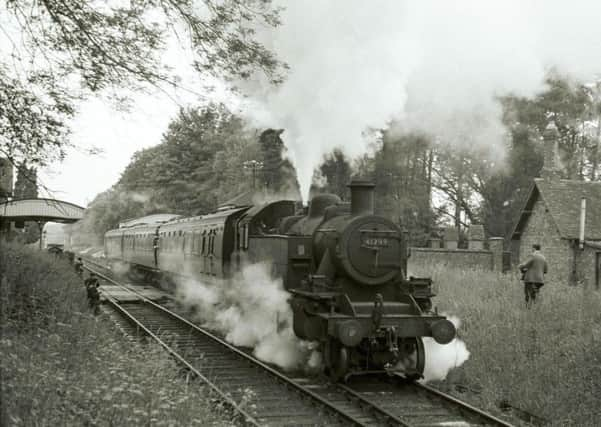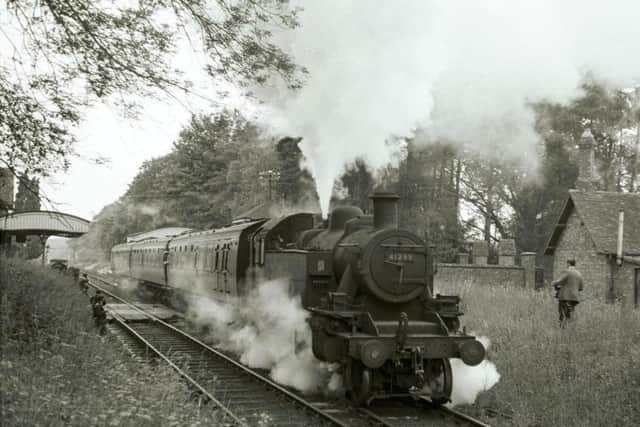Full steam ahead for library train talk
This article contains affiliate links. We may earn a small commission on items purchased through this article, but that does not affect our editorial judgement.


It was long after steam had vanished that I realized that the steam-hauled passenger trains seen at Horsham station were probably destined to travel through the Sussex countryside to Guildford.
Fifty years ago services ended on the branch to Guildford while October 2 marks the opening of the line 150 years ago.
Advertisement
Hide AdAdvertisement
Hide AdWith rail connections having been being established to both Guildford & Horsham in 1845 and 1848 respectively, an Act of 1860 authorised the Horsham & Guildford Direct Railway Company to construct a single track line 15 miles and 46 chains in length, linking the two towns.


The opening of the line was commemorated by the running of a special train, by which time the original Company had become part of the London Brighton & South Coast Railway – the main railway operator in Sussex.
The local newspaper reported: “One of the finest locomotives was dressed up in the gayest style, with the arms of the London & Brighton Company emblazoned in red and gold on the front and sides, and otherwise bedecked with evergreens and flags.
“It was a great day for the people inasmuch as the railway company allowed all who chose to have a free ride on the line.”
Advertisement
Hide AdAdvertisement
Hide AdThe train stopped off at each of the five intermediate stations with the exception of Rudgwick as the Board of Trade Inspector had decreed that the gradient was too severe and would not allow trains to stop until the gradient had been eased.
This was achieved by raising the trackbed over the River Arun by which the original brick arch became redundant as the embankment on each side had also been raised above it to enable a girder bridge some 10ft above the brick arch to carry the trains.
When the opening train reached Baynards which was really a private station for the Rev Thurlow , specially invited guests on the train, along with the band of the Brighton Volunteer Artillery, and the greeting band of 22nd Regiment, went up to his mansion in Baynards Park for an afternoon of festivities , before travelling the remainder of the line to Guildford .
The anticipated traffic along the line never materialised. Even when Christ’s Hospital School moved down from London in 1902 and the LBSCR built a station with seven platforms, the railway was used primarily by the school only at the start and end of terms as the pupils were boarders.
Advertisement
Hide AdAdvertisement
Hide AdMoreover increased traffic from the anticipated development of Horsham didn’t happen as the school owned most of the surrounding land.
Nevertheless the railway proved a lifeline for farmers carrying agricultural products and livestock to markets and for the transportation of goods especially of coal to all stations but especially to the Cranleigh Gas Works.
Little change took place to the line during the twentieth century, although it became part of the Southern Railway in 1923 and then British Railways in 1948. During the Second World War a train was bombed at Bramley resulting in seven deaths including the driver and the guard.
By the 1950s traffic figures were low owing to increased road competition with freight being moved by lorries while the local bus services were able to pick up passengers at more convenient and frequent places. Further freight traffic was lost following the 1955 rail strike, for having transferred to the road, it never returned to the railways.
Advertisement
Hide AdAdvertisement
Hide AdIn 1963 Dr Beeching published his report The Reshaping of British Railways. The Government was unwilling to continue to pour money to maintain services on uneconomic lines on purely social grounds and needed to reduce services.
The Horsham-Guildford line was one of those lines recommended for closure.
Even at this late stage new motive power in the form of Class 2 (Ivatt) tanks, and coaching stock were put into use.
A public enquiry did not prevent closure but merely delayed the date from November 11 1963 to June 14 1965. The very last train, a rail enthusiasts’ special The Wealdsman ran over the line on Sunday June 13 – the line had operated just short of 100 years.
Advertisement
Hide AdAdvertisement
Hide AdTo commemorate the 150th anniversary of the opening of the railway a small photographic display can be seen in Horsham Library.
Bill Gage of West Sussex Record Office will also be giving an illustrated talk on the history of the line.
The presentation at Horsham Library on October 1 at 7pm will include film footage taken prior to the lines closure and on the last day of operation. Tickets cost £5 and include refreshments.
To book tickets telephone Horsham Library 01403 224353.
Don’t miss out on all the latest breaking news where you live.
Advertisement
Hide AdAdvertisement
Hide AdHere are four ways you can be sure you’ll be among the first to know what’s going on.
1 Make our website your homepage at www.wscountytimes.co.uk
2 Like our Facebook page at www.facebook.com/wscountytimes
3 Follow us on Twitter @wscountytimes
4 Register with us by clicking on ‘sign in’ (top right corner). You can then receive our daily newsletter AND add your point of view to stories that you read here.
And do share with your family and friends – so they don’t miss out!
The County Times – always the first with your local news.
Be part of it.